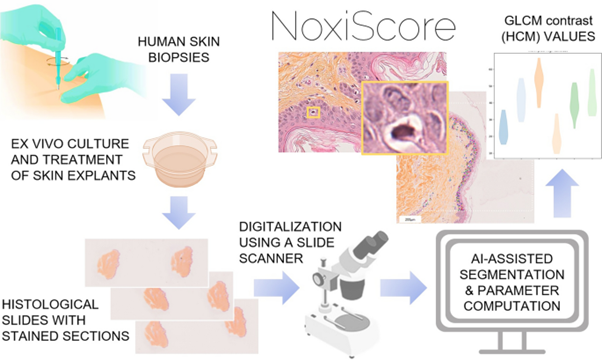No fun in the sun - AI study finds protection from sunburn might be hampered by insect repellents.
Published in Microbiology, Protocols & Methods, and Computational Sciences

Most of us enjoy a sunny day, and as we grab our sunglasses and dust off our sandals, many of us rely on two common products—sunscreen and insect repellent—to protect our skin from harmful UV rays and the bite of pesky, and potentially dangerous, insects. The latter is particularly relevant in light of the expanding distribution of day-biting insects, such as Aedes aegypti, known to transmit several arboviruses, and sandflies that can transmit leishmaniasis, to name but a few. But a new study has revealed an unexpected consequence when these two products are used together: reduced UV protection.
In a recent research study published in Parasites & Vectors, scientists used an advanced AI-powered deep-learning method called NoxiScore to analyze skin biopsies after applying sunscreen, insect repellent, and a combination of both. The results? When sunscreen and insect repellent were applied together, the UV-blocking power of the sunscreen was significantly impaired.
A deep-learning based pipeline to assess the concomitant use of sunscreen and insect repellents.
The authors describe using ex vivo human skin biopsies in their study, arguing that this simulates real-world conditions in a controlled environment, allowing them to study the direct effects of multiple products, including sun screen and insect repellent combinations, on human skin cells. This potentially provides more accurate and relevant results than the use of artificial or animal models, making this a more reliable and ethical way of studying the toxicity and effectiveness of these products on skin.
The authors applied different combinations of sunscreen and insect repellent on the skin biopsies before exposing them to UVB irradiation in the lab, or to sunlight in real-life settings. The following were tested:
- sunscreen containing UV filters alone.
- sunscreen containing UV filters and a mosquito repellent with synthetic active ingredient IR3535 (sunscreen first, followed by a mosquito repellent as often recommended).
- A commercial preparation of a natural insect repellent plus sunscreen (‘combo’).
The researchers developed and used an image analysis pipeline, starting with the application of the “treatment” to the ex vivo skin biopsies, then the preparation and digitalization of histological samples for the production of high-resolution images and finally the AI-assisted image processing and computational analysis of the data.

The results showed that while sunscreen alone effectively protected against UV exposure, the insect repellent, especially when mixed with the sunscreen, reduced the sunscreen's ability to protect the skin from UVB rays. This could lead to greater susceptibility to skin damage and even increase the risk of skin cancer in the long term.
Food for thought:
This study highlights the importance of considering how multiple products interact and underscores the need for better safety testing of combined products. While insect repellents help prevent insect-borne diseases, and sunscreens protect us from UV-induced skin damage, this research shows that combining the two may compromise both forms of protection.
The researchers argue that using deep-learning AI delivers precise, consistent and objective cell analysis, rapidly processing large amounts of data and identifying patterns and abnormalities in the skin samples. Because it is an efficient and rapid process it is a scalable analysis method and can provide predictive modelling of how the combination of insect repellent and sunscreen might impact UV protection and overall skin health. The integration of ex vivo human skin biopsies and deep learning software into a high throughput pipeline is a very innovative approach that could have applications from skin product toxicity to diagnostic and evaluation of numerous skin issues due to exposures and irritants.
AI statement - I used ChatGPT to help develop an outline for the blog, which I expanded and edited.
Follow the Topic
-
Parasites & Vectors

This journal publishes articles on the biology of parasites, parasitic diseases, intermediate hosts, vectors and vector-borne pathogens.
-
BugBitten

A blog for the parasitology and vector biology community.
Related Collections
With Collections, you can get published faster and increase your visibility.
Artificial intelligence, parasites, and parasitic diseases
As discussed in this editorial by Dantas-Torres, this collection is dedicated to articles reporting the use of AI in parasitology research. We particularly welcome articles dealing with parasitic disease diagnosis, parasite and vector identification as well as those reporting the prospection of drugs and vaccine candidates.
This collection will serve as a platform for authors to publish their research that employs AI and deep learning methods for solving research questions in the fields of parasitology and tropical medicine.
Publishing Model: Open Access
Deadline: Dec 31, 2025
Climate Monitoring and Decision Support Framework for Sand Fly-borne Diseases Detection and Mitigation – The CLIMOS Project
Articles published in the collection have already gone through the systematic peer review process of the journal.
Publishing Model: Open Access
Deadline: Jan 31, 2026




Please sign in or register for FREE
If you are a registered user on Research Communities by Springer Nature, please sign in